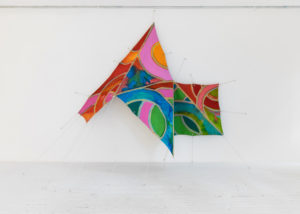
Joe Overstreet, Innovation of Flight: Paintings 1967-1972
Until May 5, 2018, Eric Firestone Gallery, New York
For Happiness, 1970
About:
Eric Firestone Gallery is pleased to announce the upcoming exhibition: Joe Overstreet, Innovation of Flight: Paintings 1967-72, on view from March 1 through May 5, 2018, and guest curated by Horace Brockington. The exhibition will focus on Overstreet’s “Flight Patterns” series: suspended canvases made in the early 1970s. A select group of shaped canvas constructions from the late 1960s will also be on view. This is the first major survey of Overstreet’s early work in decades. With this exhibition, Eric Firestone Gallery announces the representation of artist Joe Overstreet.
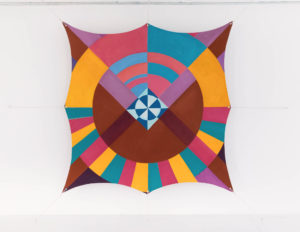
Hoodoo Mandala, 1970
The exhibition is an opportunity to revisit a radical body of work made nearly 50 years ago, and rarely seen today. In them, the language of geometric abstract painting is re-imagined into monumental installations that tell stories about the painful realities of African American history through innovative spatial structures.
Installed with ropes threaded through grommets and attached to the ceiling, wall, and floor, the work becomes architectural. The geometries are activated – referencing the dynamism of Free Jazz and the function of African art as ritual, and ceremonial objects. As Brockington states in his curatorial statement, “The complex geometry in these paintings provides compositional structure for the subsequent improvisational manipulation of texture, color, light and form on the surface.” The work is slightly different with each installation: complex formations that extend off the wall into space creating cubic geometries, dynamic angles, and pyramidal forms. The artist cedes control, allowing others to become partial authors of the work, like social sculpture.
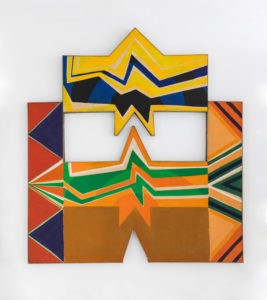
North Star, 1968
Overstreet was born in 1933 in rural Mississippi – an area mostly populated by African Americans and Choctaw Native Americans. Like many African American families who were part of the Great Migration, Overstreet’s early life was nomadic, and his early exposure was to Black and Native American rural culture. His father, a mason seeking work, drove his family across the South to find work in Thunderbolt, Georgia and then New York City. Eventually, they joined seven other families traveling west in a caravan for protection, to Washington State and Oregon, before settling in Oakland, California. These experiences would become formative in Overstreet’s work.
In the 1950s, Overstreet studied at the California School of Fine Arts (San Francisco) and California College of Arts and Crafts (Oakland). He began his career in the Bay Area, and was a fixture of the Beat scene. His Grant Street studio was located near that of Sargent Johnson, a sculptor and painter who became a mentor. Johnson was an adherent of the philosophy of Alain Locke – the “father of the Harlem Renaissance,” who advocated that African-American artists look to their ancestral legacy for aesthetic sources and inspiration. By the mid1960s, Overstreet began breaking away from the rectangle of the stretcher and from the narrative of Western art history. Drawing inspiration from the art of North Africa, Islamic mosques, art from Mali and Native American Art, he used wooden dowels shaped with a jigsaw and hand tools to make intricate stretchers, painting in patterns drawn from Aztec, Benin, and Egyptian cultures.
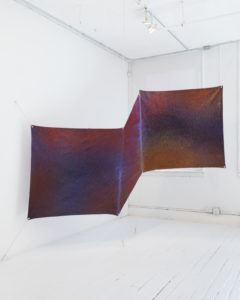
Purple Flight, 1971.
While living on Jefferson Street in New York in the 1960s, Overstreet went to John Chamberlain’s studio where Chamberlain showed him a horrifying photograph of four Black men being lynched, surrounded by celebrating white men and women. Overstreet went home and began to make paintings referencing lynching, like Strange Fruit (1965), which included images of ropes. The “Flight Pattern” paintings resound with these ideas. The painting North Star (1968), a shaped canvas construction that is part of this exhibition, moved Overstreet to look toward and consider using the ceiling. In Spirituals, and along the Underground Railroad, escaped slaves were advised to follow the North Star. The North Star was also the title Frederick Douglass gave to his anti-slavery newspaper.
As Overstreet eliminated the stretcher bars for his “Flight Patterns,” he stated, “I began to make paintings that were tent-like. I was making nomadic art, and I could roll it up and travel… I felt like a nomad myself, with all the insensitivity in America.” Overstreet was interested in maintaining the most appealing feature of nomadic structures: “their tendency, like birds in flight, to take off, to lift up, rather than be held down.” Yet, his work also makes it impossible for us to ignore the implication of these same ropes as instruments of death in lynchings across North America.
The “Flight Pattern” paintings were exhibited in their time at the Dorsky Gallery, New York; the Berkeley Rotary Art Center, Berkeley; and the DeLuxe Black Art Center, an alternative space funded by the Menil Foundation as part of the Institute for the Arts at Rice University (Houston, Texas). Overstreet’s work was also central in watershed museum exhibitions of African American artists in the period, including “Afro-American Artists: New York and Boston,” (1973) organized jointly by the Boston Museum of Fine Arts and the National Center of Afro American Artists; and “New Black Artists,” (1970) organized by the Brooklyn Museum. Overstreet was the subject of museum exhibitions at the Everson Museum of Art, Syracuse, NY (1996), and the New Jersey State Museum, Trenton, NJ (1996).
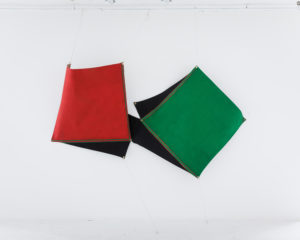
St Expedite, 1971
A “Flight Pattern” painting is part of the current exhibition “Soul of a Nation: Art in the Age of Black Power” organized by the Tate Modern, London; currently on view at Crystal Bridges Museum of American Art, and traveling this fall to the Brooklyn Museum. “Power Flight” is also in the collection of the Brooklyn Museum. Overstreet’s painting “The New Jemima” (1964, 1971) can be found in the Menil Collection. The four-panel shaped canvas construction, “Justice, Faith, Hope, and Peace,” painted in 1968 after the assassination of Martin Luther King Jr, is currently on view at the Mississippi Museum of Art where Overstreet was a recipient of the Governor’s Arts Award in February 2018.
Overstreet has been committed to social and political causes, rather than art world trends. He is recognized as a significant arts community organizer. In 1973, he and his partner Corrine Jennings established Kenkeleba House on East 2nd Street, a studio building and gallery that has presented innumerable exhibitions of work by artists of color and women, including young artists who later found acclaim like David Hammons and Keith Haring, and significant artists Norman Lewis, Edward Mitchell Bannister, and Mary Lovelace O’Neal.
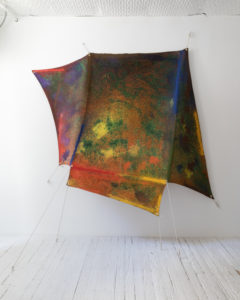
Untitled, 1972
Over the past several decades, Overstreet has been a relentless experimenter – investigating both the spatial and textural possibilities of painting, and also complex cultural histories. In revisiting this pioneering body of work by Overstreet, we begin to recognize the impact of his contribution and extent of his innovation.
